Aaron, he/him. Formerly isthecatvideocute. Animal behaviour education and cat behaviour explanations. Always happy to explain anything related to cats and spread awareness
Don't wanna be here? Send us removal request.
Text
CW: animal death, rabies
A horse just passed from aggressive rabies in Thatcher, AZ, and they couldn't euth it because it tried to attack anyone who came near, so it died in agony - they also couldn't shoot it to put it out of its misery because brain tissue has to be preserved for analysis by the state, and potential blood/brain matter spray from that method of death creates a rabies vector biohazard that can infect anyone or anything it comes in contact with. PLEASE make sure any animals you have that can have a rabies vaccine get it. It's a fairly inexpensive vaccine, and the peace of mind and protection it provides is worth it. Putting more description and the video of the horse under a readmore, all the content warnings, this video is truly horrifying, but I feel it is important for media evidence of what rabies can do to be out there for better information.
From the vet hospital's page: "This horse pulled into the clinic Monday afternoon at 1:30pm and was standing in the trailer. It went down in the trailer when we tried to get it out and it was dead two hours later. We were unable to get close to it in order to put it to sleep. Imagine the zombie apocalypse when the zombie is supposed to be dead and then jumps up and tries to chase the human with half its body gone. The horse presented after fighting with another horse over the corral fence, that horse was euthanized today by the office of the Arizona State Veterinarian due to significant exposure to rabies and not having ever been vaccinated. The horse destroyed a mesquite tree by trying to rip it apart with its mouth and the owner was somehow able to get it into the trailer without being injured and bring it to the clinic.
When it arrived it was mouth chomping and self mutilating its front leg. It went down and it trashed and it would try to attack you if you went into the trailer.
3K notes
·
View notes
Note
Do indoor only cats with no catio or cat harness and no other pets in the home need flea and tick prevention?
Yes.
Fleas travel. Outdoor cats and other mammalian wildlife venture around your home. Neighbors might have pets with fleas. Fleas will hop onto clothing and travel with you for long distances.
379 notes
·
View notes
Video
#that dog is what#fourteen pounds?#twenty max?#it does not stand a chance and that elephant could so easily kill it even on accident#don't let pets interact with wildlife#and definitely do not do this#dogs
2K notes
·
View notes
Note
People so often fail to remember that the family dog is a dog first, your pet second. Even a chill dog has a point where it will snap because above all else dogs are animals, and animals can only be pushed so far before they fight back. Even your angel dog. So if your kid annoys any dog too much, the dog will snap (hopefully after warnings but kids are often bad at ignoring warnings.) And with dogs like pitties, who are one of the biggest breeds in the nanny breed misconception, they can seriously hurt a child if the child provokes them into snapping.
Do not leave your kids unsupervised around dogs until you know for a fact that they are old enough to respect the dog. Babies and toddlers should never be left alone with a dog- my dad used to say that a dog should never be closer to a small child than the parent is, and I consider that a very good rule of thumb. Supervise all interactions between small children and dogs to make sure the interaction is safe at all times.
Even a chill dog will snap at a child if sufficiently provoked. Parents need to be aware of that so they can keep that from happening
Is there such a thing as “nanny dogs?”
No.
There might be individual dogs with high tolerances for nonsense from children (my childhood dog for example), but no dog should be left unsupervised with young children for the dog's safety as well as the kid's.
584 notes
·
View notes
Text

Bad hamster wheel. Running wheels should have at the very least a closed running surface, and one of the sides should be closed, too, to reduce the risk of the hamster getting hurt while running. I can't tell if the wheel is big enough, but the running surface and one of the sides should be closed.
1 note
·
View note
Text




Why is it always the exotic cats that are allowed to get morbidly obese???
(It's probably deliberate to make them easier to handle)
#jesus fucking christ#animal cruelty#unsafe animal keeping#those animals have got to be suffering in those first pictures
206 notes
·
View notes
Text
Alligator Body Language and You, or: How To Know When An Alligator On Social Media is Being Stressed for Views
Alligators are wild animals. Despite the idiotic claims of animal abusers like Jay Brewer, they cannot be domesticated, which means they are always going to react on the same natural instincts they've had for millions of years. Habituated, yes. Tamed, yes. Trained, definitely. Crocodilians can form bonds with people- they're social and quite intelligent. They can solve problems, use tools, and they're actually quite playful. Alligators are also really good at communicating how they're feeling, but to somebody who doesn't spend much time around them, their body language can be a bit mystifying. And it doesn't help when social media influencers are saying shit like this:

That is not what a happy gator looks like.
That's a terrified, furious gator who isn't attacking because the ogre handling her has her in a chokehold. She's doing everything she can to express her displeasure, and he's lying about it because he knows his audience doesn't even know how to think critically about what he's doing. He knows that because his audience doesn't know anything about these animals, he can get away with it. This I think is why I hate him so much- he deliberately miseducates his audience. He knows what he's doing is factually inaccurate, he just doesn't care because attention means more to him than anything else in the world.
Let's change that! Here are two really important lessons for understanding alligator body language on social media.
Lesson 1: Alligators Don't Smile (in fact, most animals don't)
So what's going on in this video? Jay Brewer is aggressively choking his white alligator Coconut while scrubbing algae off of her with a toothbrush. And make no mistake, he is digging into the creature's throat while she is visibly distressed. He claims she's happy- but she's not. He is willfully misrepresenting what this animal is feeling. That's a problem, because people... well, we actually kind of suck at reading other species' body language. The reason for this is that we tend to overlay our own responses on their physical cues, and that's a problem. For example, let's look at an animal with a really similar face to ours, the chimpanzee. Check out Ama's toothy grin!

Wait, no. That's not a happy smile. That's a threat display. When a chimpanzee "smiles," it's either terrified and doing a fear grimace, or it's showing you its teeth because it intends on using them in your face.
How about a dog? Look at my smiling, happy puppy!
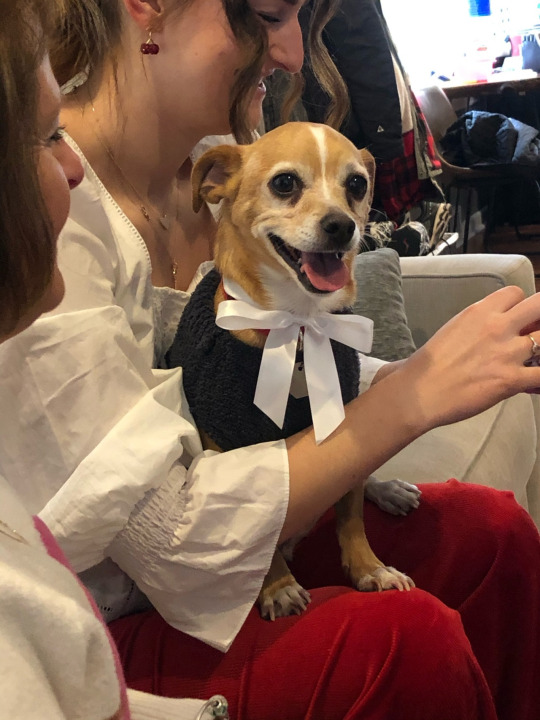
Oh wait no, this is a picture of Ryder when he was super overwhelmed by noise and people during a holiday party. He'd hopped up in my sister's lap to get away from stuff that was happening on the floor and was panting quite heavily. See the tension in the corners of his mouth and his eyes? A lot of the time when a dog "smiles," the smile isn't happy. It's stress! Why Animals Do The Thing has a nice writeup about that, but the point is, our body language is not the same as other species. And for reptiles, body language is wildly different.
For instance, look at these two alligators. Pretty cute, right? Look at 'em, they're posing for a Christmas card or something! How do you think they're feeling?

Well, I'll tell you how the normal one is feeling. He's annoyed! Why is he annoyed? Because the albino just rolled up, pushed another gator off the platform, and is trying to push this guy, too. I know this because I actually saw it happen. It was pretty funny, not gonna lie. He's not gaping all the way, but he was hissing- you can actually see him getting annoyed in the sequence I took right before this shot. Look at him in this first shot here- he's just relaxing, and you can see he isn't gaping even a little bit.
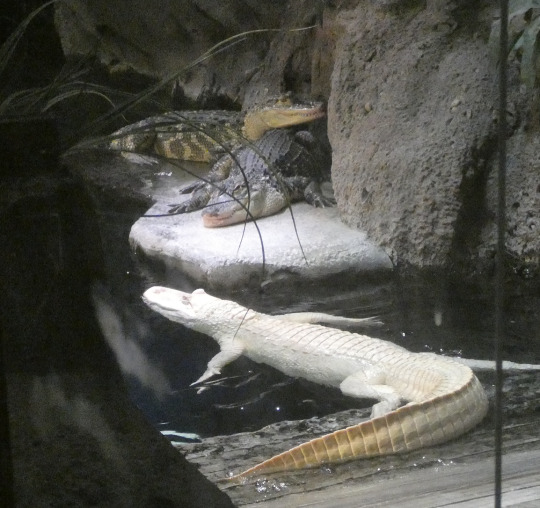

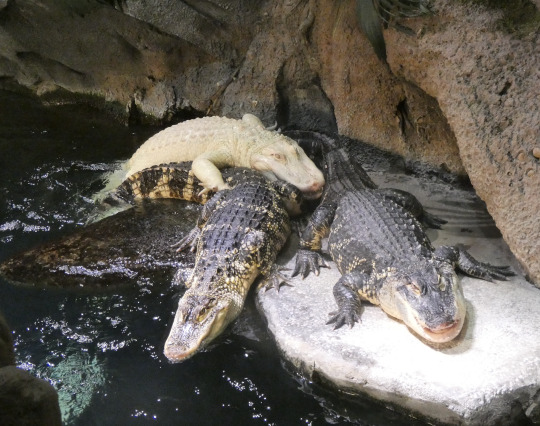
By the end, he's expressing displeasure, but not enough to actually do anything about it. He's annoyed, but he's comfy and that's where one of the best basking areas is, so he'll put up with it.
Reptiles open their mouths wide for a lot of reasons, but never because they are actively enjoying a sensation. Unless they're eating. No reptile smiles- they can't. They don't even have moveable lips. If a reptile is gaping, it's doing so because:
It is doing a threat display.
It is making certain vocalizations, all of which are threats. Alligators are one of the rare reptiles that do regularly vocalize, but most of their calls aren't made with a wide open mouth.
It is about to bite something delicious or somebody stupid. Check out this video- virtually all of the gaping here is anticipatory because these trained gators know darn well that the bowl is full of delicious snacks. (I have some issues with Florida's Wildest, but the man knows how to train a gator AND he is honest about explaining what they're doing and why, and all of his animals are healthy and well-cared for, and he doesn't put the public or his staff at risk- just himself.)
youtube
It's too hot and it has opened its mouth to vent some of that heat and thermoregulate. This is the main reason why alligators will often have their mouths part of the way open, but sometimes they'll open all the way for thermoregulation. This is what a thermoregulatory gape looks like- usually it's not all the way open, kinda more like < rather than V, but you can't say that 100% of the time. Additionally, a thermoregulatory gape... typically happens when it's hot out. If they're inside, maybe they've been under their basking light for too long. Heat's the dominant factor, is what I'm getting at.
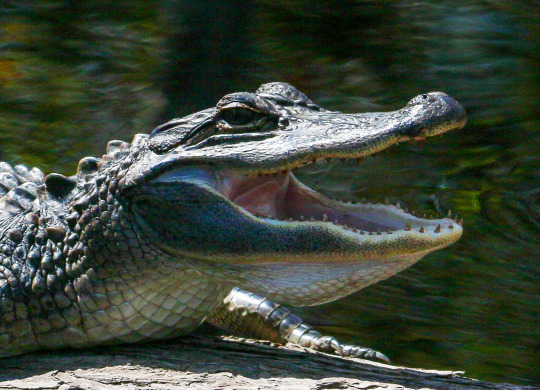
There is another reason that a captive crocodilian might be gaping, and that's because it's doing so on command. Some places have their gators trained to gape on cue, like St. Augustine Alligator Farm and other good zoos. They have the animals do this in presentations that are genuinely educational. They ask the animals to open their mouths so that they can show off their teeth and demonstrate how their tongues seal off the back of their mouth. They'll also do it as part of routine healthcare, because looking at their teeth is important.
In this case, the animals aren't gaping because they're stressed, they're gaping because they know they're gonna get a piece of chicken or fish if they do it. And what's more, they're doing it on cue. They have a specific command or signal that tells them to open wide. It's not an instinctive response to a situation. It's trained. If the animal provides the behavior after a cue, the situation is much less likely to be negatively impactful.
It's also important to remember that there's a difference between a partially open mouth and a gape! As discussed above, alligators will often have their mouths a little bit open just to maintain temperature homeostasis. It helps them stay comfy, temperature-wise. These guys are all doing thermoregulatory open-mouthed behavior- that slight open and relaxed body posture is a dead giveaway. (That and it's the hottest spot in the enclosure.)
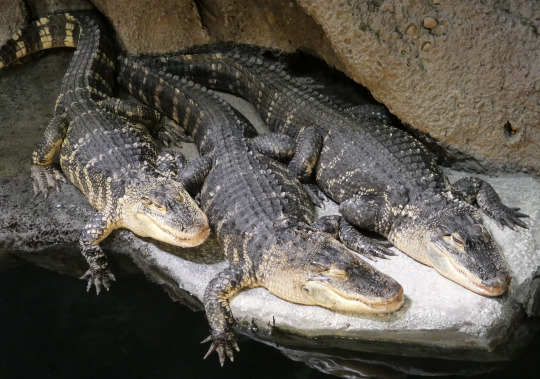
Lesson 2: A Happy Gator Is A Chill Gator
So if alligators don't smile or have facial expressions other than the :V that typically signifies distress, how else can you tell how they're feeling? One way is stillness. See, alligators subscribe to the philosophy of if it sucks... hit da bricks.

Basically, if they hate it, they'll leave. Unless, y'know, somebody has their meaty claws digging into their throat or is otherwise restraining them. (Restraint isn't always bad, btw. Sometimes the animal is going through a medical thing or needs to be restrained for their safety- which a responsible educator will explain.)
Let's look at a very similar scenario, in which a captive alligator is getting his back scrubbed.
As you can see, it's quite different. First, he's not being restrained at all. Second, look at how relaxed he is! He's just chilling there vibing! He could simply get up and leave if he wanted to, because he's not being held. Towards the end of the video, as he lifts his head, you can see that his respiratory rate is very even as his throat flutters a bit. I'm not sure what this facility is, so I can't comment on care/general ethics, but like. In this specific case, this is an alligator enjoying being scrubbed! And you can tell because he's not doing anything. A happy gator is content to be doing what they're doing.
Why Should I Listen To You?
Now, you should ask yourself, why should you listen to me? Why should you trust me, who does not own an alligator, versus Jay Brewer, who owns several?
Well, first off, there's no profit for me in telling you that what you're seeing on social media is in fact not what you're being told you're seeing. I'm not getting paid to do this. That's the thing with people who make social media content. The big names aren't doing it just for fun. They're doing it for money. Whether that's profit through partnerships or sponsorships, or getting more people to visit their facilities, or ad revenue, you can't ignore the factor of money. And this is NOT a bad thing, because it allows educators to do what they're passionate about! People deserve to be paid for the work that they do!
But the problem starts when you chase the algorithm instead of actually educating. A "smiling" alligator gets the views, and if people don't know enough to know better, it keeps getting the views. People love unconventional animal stories and they want those animals to be happy- but the inability to even know where to start with critically evaluating these posts really hinders the ability to spread real information. Like, this post will probably get a couple hundred notes, but that video of Coconut being scrubbed had almost 400,000 likes when I took that screenshot. Think about how many eyeballs that's reached by now. What I'm saying here is that it's just... really important to think critically about who you're getting your information from. What do dissenters say in the comments? What do other professionals say? You won't find a single herpetologist that has anything good to say about Prehistoric Pets, I can tell you that right now.
Another reason you can trust me is that my sources are not "just trust me bro," or "years of experience pretending my pet shop where animals come to die is a real zoo." Instead, here are my primary sources for my information on alligator behavior:
Dragon Songs: Love and Adventure among Crocodiles, Alligators, and Other Dinosaur Relations- Vladimir Dinets
The Secret Social Lives of Reptiles- J. Sean Doody, Vladimir Dinets, Gordon M. Burghardt
Social Behavior Deficiencies in Captive American Alligators (Alligator mississippiensis)- Z Walsh, H Olson, M Clendening, A Rycyk
Social Displays of the American Alligator (Alligator mississippiensis)- Kent Vliet
Social Signals and Behaviors of Adult Alligators and Crocodiles- Leslie Garrick, Jeffery Lang
Never smile at a crocodile: Gaping behaviour in the Nile crocodile at Ndumo Game Reserve, South Africa- Cormac Price, Mohamed Ezat, Céline Hanzen, Colleen Downs (this one's Nile crocs, not American alligators, but it's really useful for modeling an understanding of gape behaviors and proximity)
Thermoregulatory Behavior of Captive American Alligators (Alligator mississippiensis)- Cheryl S. Asa, Gary D. London, Ronald R. Goellner, Norman Haskell, Glenn Roberts, Crispen Wilson
Unprovoked Mouth Gaping Behavior in Extant Crocodylia- Noah J. Carl, Heather A. Stewart, Jenny S. Paul
Thank you for reading! Here's a very happy wild alligator from Sanibel for your trouble.
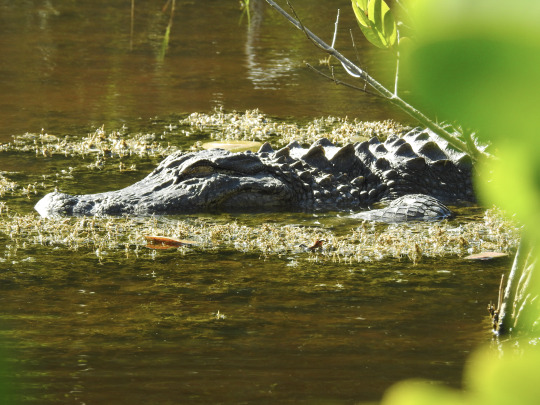
37K notes
·
View notes
Text
This Thanksgiving…
- Save your pet the stomachache…
- Save your vet the headache…
- Save yourself the heartache…
Sharing isn’t caring!!! Fatty Thanksgiving foods lead to pancreatitis, which can be life-threatening. I know they’re cute when they beg, but it’s for their own good.
3K notes
·
View notes
Text
PSA: BAD LITTERBOX
i don't usually make posts like this, but this is a truly upsetting topic to me as a lifelong cat owner, so i feel i have a duty to share my knowledge with others.
there is a type of automatic litterbox for cats being sold that is EXTREMELY dangerous and has killed numerous cats through blunt force trauma, suffocation, etc. this litterbox is being sold under different brand names and logos, so i will include the picture of the model and two links to informational videos with more evidence and eloquence than i am able to provide.
please consider not having this type of litterbox in your home for your furry friends. me and my 16 year old tortie, puddy, want the best for all your kitty friends
image of litterbox below:

here are my two video links that provide proof and testimonials of this harmful product:
This Scam is Killing Cats by penguinz0
The DEADLY self-cleaning litter boxes that have flooded the market by One Man Five Cats
39K notes
·
View notes
Text


Where the chain? 🤨
118 notes
·
View notes
Text
getting a wolfdog for protection is so fucking dumb. ma'am you know wolves are naturally timid of humans, right? you could grab literally any shepherd or pit mix from your local shelter and it will guard your house better than a wolfdog and destroy your house slightly less
558 notes
·
View notes
Text
No, you don't need a coydog as a pet. No, you don't need a wolfdog as a pet. No, you don't need a wild canid as a pet.
2K notes
·
View notes
Text
had an interaction with a cat at my mother's friend's house (we dropped by to feed her while my mom's friend was out of town) and my mother said "i was surprised how much that cat liked you, she doesn't usually let people pet her but she followed you around and let you pet her a lot"
and in explaining to her my interaction with the cat i put into words a thing i'd never put into words before, having always automatically understood what i was doing. But once i put it into words my mother said she'd never thought of that and it felt like something worth sharing here.
This cat did a typical cat thing where she sniffed my fingers i was holding out, and then acted like she wanted me to pet her, but then when i started to move to pet her, moved her head away slightly to prevent it.
I instinctively understand this interaction, and stopped trying to pet her and moved back to a neutral position and waited to see if she would re-initiate an interaction.
Because this is basically a consent test. This is how a cat can assess "how closely are you paying attention to what i'm telling you" and "how respectful of my boundaries are you".
If i am responsive to her yes/no game, moving to pet her when she indicates i can, stopping immediately when she seems to change her mind, then she knows she can trust me to understand her, and also to respect her choices. That's what i did, so then she knew she could trust me and relax around me and enjoy my company. She was actually a very friendly and social little cat, who clearly wanted to make friends with me.
But if i had insisted on trying to pet her when she seemed to change her mind instead of simply understanding that she didn't want to be pet in that moment, she would have known she couldn't trust me to understand or respect her, and she would have treated me like she has to treat 90% of the people who visit that house, evidently.
I work mostly with dogs these days, but i grew up with cats too, and am generally good with animals. Many shy animals will also do this same "sniff sniff okay touch me nope just kidding" routine, especially if they've had experiences with people that make establishing that kind of communication and trust important to them.
And in fact, a lot of animals will do some version of this kind of consent test in a whole variety of situations. When well socialized dogs do that thing where they are rough housing and then they both stop suddenly for a moment until one of them play bows or makes a little pouncing motion and then they fly back into rough housing mode, that's what they are doing, they are doing a consent check-in, like "whoah this is getting wild, are you still in? are we still playing, is this still a good time for you?"
anyway, that's why this lovely little cat followed me around asking me to pet her the whole time we were visiting that house, because i showed her that i understood her signals and respected her boundaries, which is something i see a lot of both men and women not doing when interacting with cats and dogs.
32K notes
·
View notes
Text
Me every time I see someone with a “pet” serval or high content savannah cat:
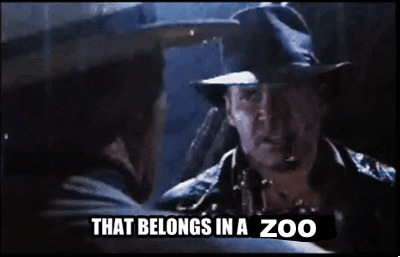
958 notes
·
View notes

